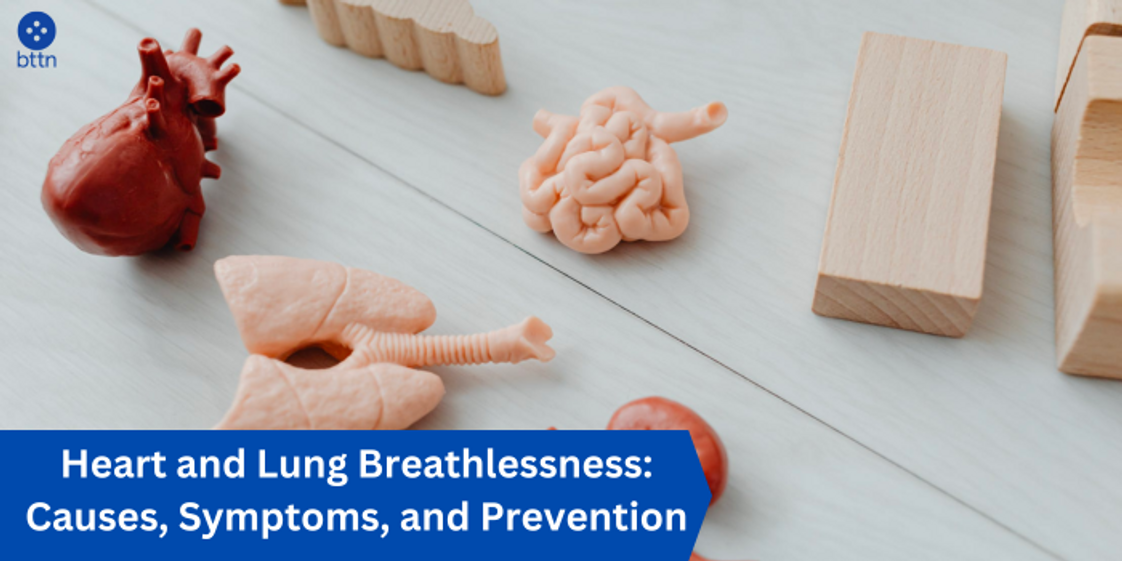
Heart and Lung Breathlessness: Causes, Symptoms, and Prevention
Posted by Pankaj Dhiman on Sep 12th 2023
In today's fast-paced world, the occasional feeling of breathlessness can be dismissed as a consequence of our hectic lifestyles. However, it's crucial not to overlook it, as breathlessness can often be a sign of an underlying health issue. Two of the most common causes of breathlessness are heart-related and lung-related problems. In this blog, we will delve into the differences between the two, explore the symptoms, and discuss preventive measures to maintain optimal heart and lung health in 2023.
Understanding Heart-Related Breathlessness
- Heart Failure: One of the primary heart-related causes of breathlessness is heart failure. When the heart's pumping action becomes weak or inefficient, it fails to circulate blood effectively, leading to a buildup of fluid in the lungs. This fluid accumulation in the lungs is called pulmonary edema, and it results in breathlessness, especially during physical exertion or when lying down.
- Coronary Artery Disease (CAD): CAD occurs when the blood vessels supplying the heart become narrowed or blocked due to the buildup of plaque. This reduces blood flow to the heart muscle, leading to chest pain (angina) and breathlessness, particularly during activities that demand increased oxygen delivery to the heart.
- Arrhythmias: Abnormal heart rhythms, known as arrhythmias, can also cause breathlessness. When the heart beats too fast (tachycardia) or too slowly (bradycardia), it may not pump blood effectively, resulting in reduced oxygen delivery to the body.
Understanding Lung-Related Breathlessness
- Chronic Obstructive Pulmonary Disease (COPD): COPD is a group of lung conditions, including chronic bronchitis and emphysema, that obstruct airflow and make it difficult to breathe. Over time, COPD can lead to chronic breathlessness, especially during physical activities.
- Asthma: Asthma is a chronic lung condition characterized by inflammation and narrowing of the airways. This can cause sudden breathlessness, wheezing, and coughing, often triggered by allergens or environmental factors.
- Pneumonia: Lung infections like pneumonia can lead to breathlessness due to the inflammation and fluid accumulation in the air sacs (alveoli). This condition impairs the exchange of oxygen and carbon dioxide in the lungs.
Distinguishing Between Heart and Lung-Related Breathlessness
Both heart and lung-related breathlessness share common symptoms, making it challenging to differentiate between them solely based on signs. However, some key differences can help in identifying the root cause:
- Heart-Related Breathlessness:
- Typically worsens with physical exertion or lying flat.
- Often accompanied by swelling in the ankles, legs, or abdomen.
- May be associated with chest pain or discomfort.
- Lung-Related Breathlessness:
- May have a chronic nature and persist even at rest.
- Often associated with coughing, wheezing, or a history of lung diseases.
- May be triggered or worsened by exposure to allergens or irritants.
Preventing Heart and Lung-Related Breathlessness in 2023
Prevention is always better than cure, and maintaining heart and lung health should be a top priority. Here are comprehensive strategies to prevent breathlessness associated with heart and lung issues:
1. Regular Exercise: Engaging in regular physical activity is crucial for heart and lung health. Aim for at least 150 minutes of moderate-intensity exercise per week. Activities like brisk walking, swimming, and cycling improve cardiovascular fitness and lung function.
2. Balanced Diet: Adopt a heart-healthy diet rich in fruits, vegetables, whole grains, lean proteins, and low-fat dairy. Avoid excessive salt and processed foods, which can contribute to hypertension and heart problems.
3. Smoking Cessation: If you smoke, quitting is the single most important step to protect your lungs and heart. Smoking damages lung tissue and increases the risk of heart disease.
4. Manage Stress: Chronic stress can negatively impact heart and lung health. Incorporate stress-reduction techniques like mindfulness, meditation, and deep breathing exercises into your daily routine.
5. Regular Check-ups: Routine medical check-ups are essential for early detection and management of heart and lung conditions. Keep up with regular appointments with your healthcare provider.
6. Vaccinations: Stay up-to-date with vaccinations, especially flu and pneumonia shots. These can prevent infections that might lead to lung-related breathlessness.
7. Allergen Management: If you have allergies, take measures to minimize exposure to triggers. Keep your home clean, use air purifiers, and follow your healthcare provider's advice on allergy management.
8. Medication Adherence: If you have a diagnosed heart or lung condition, ensure that you follow your prescribed treatment plan diligently. Medications and therapies can help manage symptoms and prevent complications.
9. Weight Management: Maintain a healthy weight through a balanced diet and regular exercise. Excess weight can strain both the heart and lungs, leading to breathlessness.
10. Environmental Awareness: Be conscious of environmental factors that can affect your lung health, such as air pollution and secondhand smoke. Take steps to minimize exposure.
Conclusion
Breathlessness can be a concerning symptom, and understanding whether it is heart-related or lung-related is essential for proper diagnosis and treatment. In 2023, prioritize your heart and lung health by adopting a healthy lifestyle, seeking regular medical care, and implementing preventive measures. By doing so, you can reduce the risk of breathlessness and enjoy a healthier and more active life.
Remember, your health is in your hands, and taking proactive steps today can lead to a breath of fresh air tomorrow.
